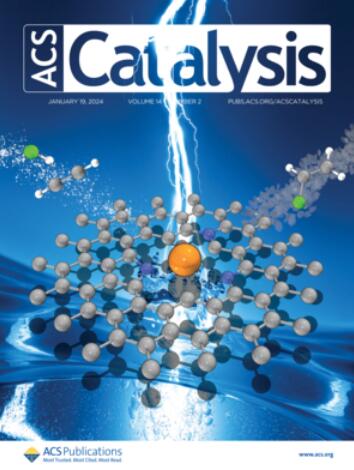Structural Insights into Ni–Fe Layered Double Hydroxides as Anode Catalysts for Pairing CO2 Reduction and Ethylene Glycol Oxidation
IF 11.3
1区 化学
Q1 CHEMISTRY, PHYSICAL
引用次数: 0
Abstract
Harnessing renewable electricity for CO2 electroreduction is essential for the low-carbon production of chemicals and fuels. Traditional methods combine the CO2 reduction reaction (CO2RR) with the oxygen evolution reaction (OER), which has high energy consumption and low-value products. Here, we propose using anodic ethylene glycol oxidation reaction (EGOR) instead of OER, which has a lower oxidation potential and valuable product. Nickel–iron layered double hydroxide (NiFe-LDH) is identified as an efficient EGOR catalyst. Using systematic electrochemical measurements and both ex situ and operando spectroscopy revealed that NiFe-LDH undergoes distinct structural evolution under EGOR and the OER. We found that metal–oxygen hybridization enhances EGOR selectivity and reduces the OER selectivity. Pairing EGOR with CO2RR allowed achieving a low electrical consumption of 6.2 kWh Nm–3 at 300 mA cm–2 for CO production using Ag as the cathode. This strategy was successfully applied to the conversion of CO2 to multicarbon products, demonstrating a partial current density of 364 mA cm–2 for C2+ production using Cu2O as the cathode.

Ni-Fe层状双氢氧化物作为配对CO2还原和乙二醇氧化阳极催化剂的结构见解
利用可再生电力进行二氧化碳电还原对于化学品和燃料的低碳生产至关重要。传统方法将CO2还原反应(CO2RR)与析氧反应(OER)相结合,能耗高,产物价值低。在此,我们提出用阳极乙二醇氧化反应(EGOR)来代替氧化电位更低、产物更有价值的OER。镍铁层状双氢氧化物(NiFe-LDH)是一种高效的EGOR催化剂。系统电化学测量和非原位和操作光谱分析表明,在EGOR和OER作用下,NiFe-LDH发生了不同的结构演变。我们发现金属氧杂化提高了EGOR选择性,降低了OER选择性。将EGOR与CO2RR配对,可以在300 mA cm-2下实现6.2 kWh Nm-3的低电耗,用于使用Ag作为阴极的CO生产。该策略已成功应用于将CO2转化为多碳产品,证明了以Cu2O为阴极生产C2+的偏电流密度为364 mA cm-2。
本文章由计算机程序翻译,如有差异,请以英文原文为准。
求助全文
约1分钟内获得全文
求助全文
来源期刊

ACS Catalysis
CHEMISTRY, PHYSICAL-
CiteScore
20.80
自引率
6.20%
发文量
1253
审稿时长
1.5 months
期刊介绍:
ACS Catalysis is an esteemed journal that publishes original research in the fields of heterogeneous catalysis, molecular catalysis, and biocatalysis. It offers broad coverage across diverse areas such as life sciences, organometallics and synthesis, photochemistry and electrochemistry, drug discovery and synthesis, materials science, environmental protection, polymer discovery and synthesis, and energy and fuels.
The scope of the journal is to showcase innovative work in various aspects of catalysis. This includes new reactions and novel synthetic approaches utilizing known catalysts, the discovery or modification of new catalysts, elucidation of catalytic mechanisms through cutting-edge investigations, practical enhancements of existing processes, as well as conceptual advances in the field. Contributions to ACS Catalysis can encompass both experimental and theoretical research focused on catalytic molecules, macromolecules, and materials that exhibit catalytic turnover.
 求助内容:
求助内容: 应助结果提醒方式:
应助结果提醒方式:


